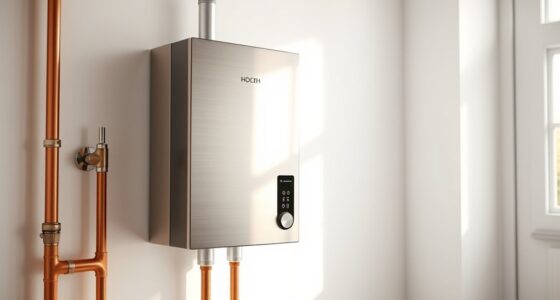Induction stoves use electromagnetic fields to heat cookware directly, making cooking faster, safer, and more energy-efficient. When you turn one on, electricity powers coils beneath a smooth surface, creating magnetic fields that induce currents in ferromagnetic pots and pans. This allows precise temperature control and keeps the cooktop cooler. Future innovations will include smart features, remote controls, and better energy management, helping you cook more efficiently and safely—there’s plenty more to discover about what’s coming next.
Key Takeaways
- Induction stoves use electromagnetic fields to heat cookware directly, offering faster and more precise temperature control than traditional methods.
- They are safer with cooler surfaces, reducing burn risks and enabling easier cleanup due to the absence of open flames or hot coils.
- Future models will integrate smart technology, sensors, and remote controls for enhanced convenience, safety, and energy efficiency.
- Induction technology is more energy-efficient, lowering utility bills and environmental impact through targeted, efficient heat transfer.
- Advanced features like customizable cooking programs and connectivity will make induction stoves more versatile for modern lifestyles.
The Science Behind Induction Heating
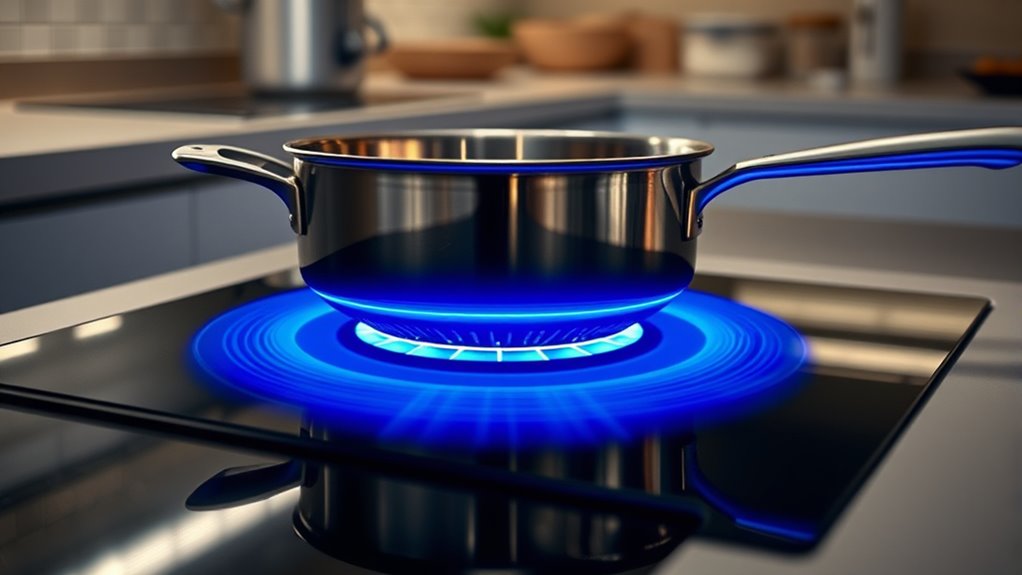
Induction heating works by generating an electromagnetic field that directly heats cookware, rather than the cooktop itself. When you turn on an induction stove, electric currents flow through a coil beneath the surface, creating strong magnetic fields. These magnetic fields induce electric currents—called eddy currents—in the ferromagnetic cookware placed on the surface. The heat transfer occurs because these currents cause the metal to rapidly heat up through electrical resistance. Unlike traditional stoves, induction heats cookware directly, offering quick and efficient thermal transfer. This process minimizes wasted energy and allows for precise control of temperature. Because magnetic fields are confined to the cookware, induction stoves are safer and more energy-efficient, providing fast, reliable heating for your cooking needs. Additionally, the color accuracy of the heating process ensures consistent temperature distribution across the cookware.
Components of an Induction Stove

The main components that make an induction stove work efficiently include the cooking surface, the electromagnetic coil, the power supply, and the control system. The cooking surface is usually smooth glass or ceramic, designed to transfer heat quickly. Beneath it lies the induction coil, an electromagnetic coil that generates a magnetic field when powered. This coil creates the energy needed to heat your cookware directly. The power supply provides the necessary electricity, converting it into controlled energy for the coil. The control panel allows you to adjust temperature settings and monitor the stove’s operation. It communicates with the internal control system, ensuring precise heating and safety features. Incorporating vertical storage solutions and other organization strategies can help keep your kitchen clutter-free, making it easier to maintain your induction stove and other appliances. Together, these components work seamlessly to deliver fast, efficient, and safe induction cooking.
How Induction Cooking Differs From Traditional Methods

Unlike traditional cooking methods that rely on direct heat transfer from flames or heated coils, induction cooking uses electromagnetic fields to heat cookware directly. This difference markedly impacts cooktop design, which features smooth, flat surfaces with touch controls instead of burners or dials. The user interface on induction stoves is typically more intuitive, offering precise temperature adjustments and quick response times. Because heat is generated directly in the cookware, the cooktop itself stays cooler, reducing the risk of burns and making cleanup easier. In contrast, traditional stoves often have visible flames or hot coils, which can be less efficient and harder to control. Overall, induction cooking provides a modern, efficient, and user-friendly alternative rooted in advanced technology.
Benefits of Using Induction Stoves
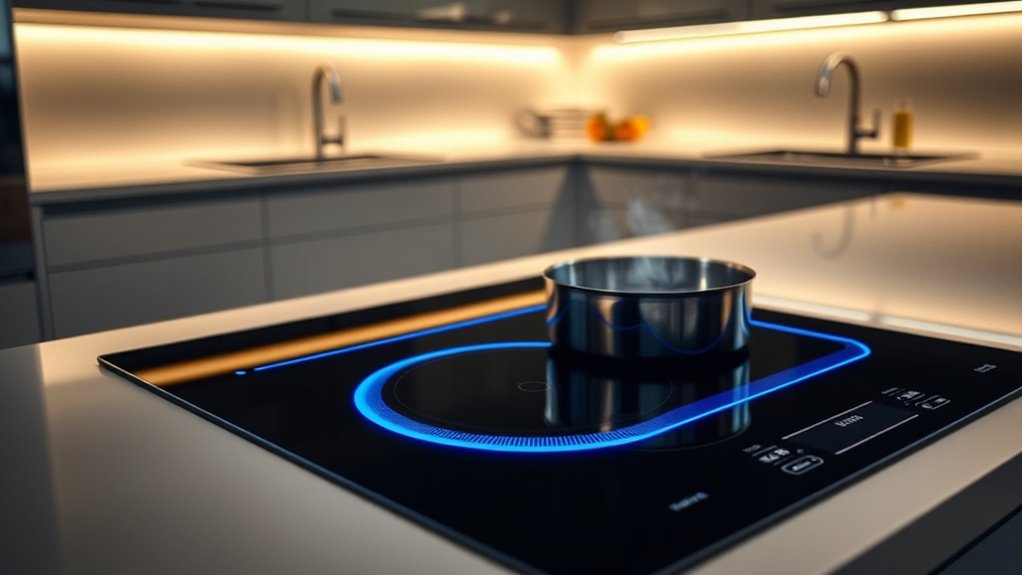
Induction stoves heat up your cookware much faster, saving you time in the kitchen. They also use energy more efficiently, which can lower your utility bills. Plus, with their surface staying cooler, cooking becomes safer and less messy. Additionally, because they require proper skin prep to ensure even heating and prevent damage, following recommended practices can enhance your overall cooking experience.
Faster Heating Times
Because induction stoves heat cookware directly through electromagnetic energy, they can reach desired temperatures much faster than traditional gas or electric stoves. This speed enhances your cooking precision, allowing you to adjust heat instantly and avoid overcooking. Plus, faster heating means less time waiting and more time enjoying your meals. The sleek design also boosts kitchen aesthetics, creating a modern, clutter-free look. To visualize, here’s a comparison of heating times:
| Cookware Type | Gas Stove | Induction Stove |
|---|---|---|
| Boiling Water | 6 minutes | 3 minutes |
| Searing Steak | 4 minutes | 2 minutes |
| Simmering Soup | 10 minutes | 5 minutes |
| Melting Chocolate | 5 minutes | 2.5 minutes |
| Warming Milk | 4 minutes | 2 minutes |
Induction stoves deliver speed, precision, and style all in one, with efficient energy transfer ensuring minimal heat loss during cooking.
Enhanced Energy Efficiency
Since induction stoves directly transfer electromagnetic energy to cookware, they consume less power while delivering rapid heating. This efficiency means you’ll use less electricity, reducing your environmental impact. The design often incorporates eco friendly materials that are durable and sustainable, further supporting energy conservation. Plus, the user interface on induction stoves is intuitive, allowing you to precisely control heat levels and avoid wasting energy. Unlike traditional stoves, they heat only the cookware, minimizing heat loss and ensuring that most energy goes directly into cooking. This targeted heating not only saves energy but also shortens cooking times. Additionally, tuning techniques used in electronics can optimize induction stove performance and energy use. Overall, induction stoves offer an eco-conscious choice that balances performance with energy efficiency, making them a smarter, more sustainable option for your kitchen.
Safer Cooking Environment
One of the key safety benefits of induction stoves is that they only heat cookware, not the surrounding area. This reduces the risk of burns and accidental fires, making your kitchen safer. Child safety improves because children can’t easily touch hot surfaces or accidentally turn on the stove. Additionally, induction cooking produces less smoke and fumes compared to traditional stoves, leading to better indoor air quality. With no open flames or exposed heating elements, you minimize the chances of burns or fires caused by spills or contact. The precise heat control also means you’re less likely to cause overheating or accidents. Overall, induction stoves provide a safer environment for everyone in your home, especially children, while helping you cook more efficiently and with fewer hazards.
Safety and Energy Efficiency Features
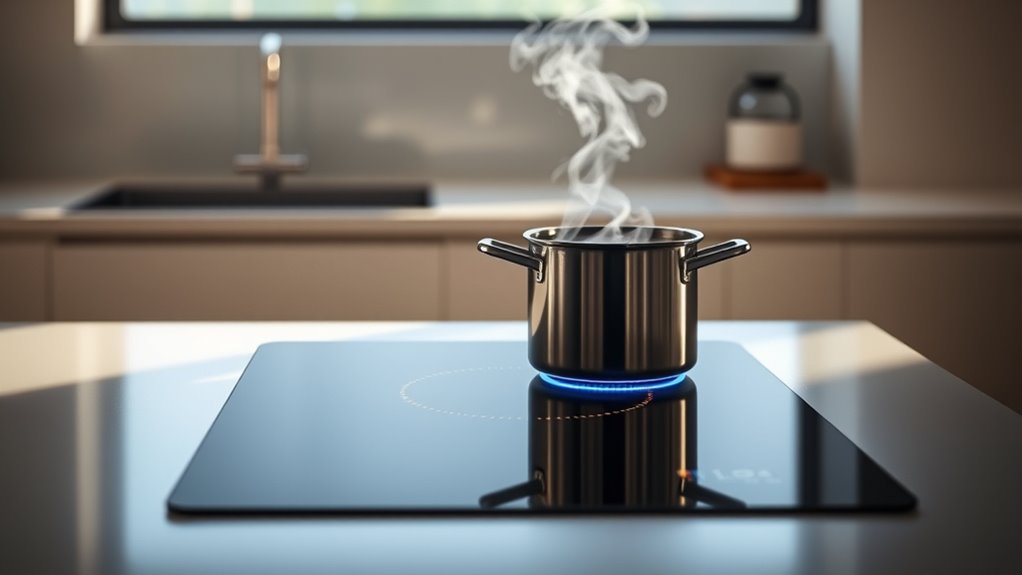
Induction stoves are designed with safety and energy efficiency in mind, making them a smart choice for modern kitchens. Child safety is a top priority, so many models include features like lock functions to prevent accidental activation. This means kids can’t turn on or change settings without adult supervision. Additionally, induction stoves only heat when a compatible pan is on the surface, reducing the risk of burns from hot surfaces or spilled liquids. These stoves also save energy by quickly heating cookware and shutting off automatically once cooking is done. The precise control not only conserves power but also ensures you use only what you need. Because of their advanced technology, induction stoves offer a safer, more efficient cooking experience perfect for busy households.
Future Trends and Innovations in Induction Technology
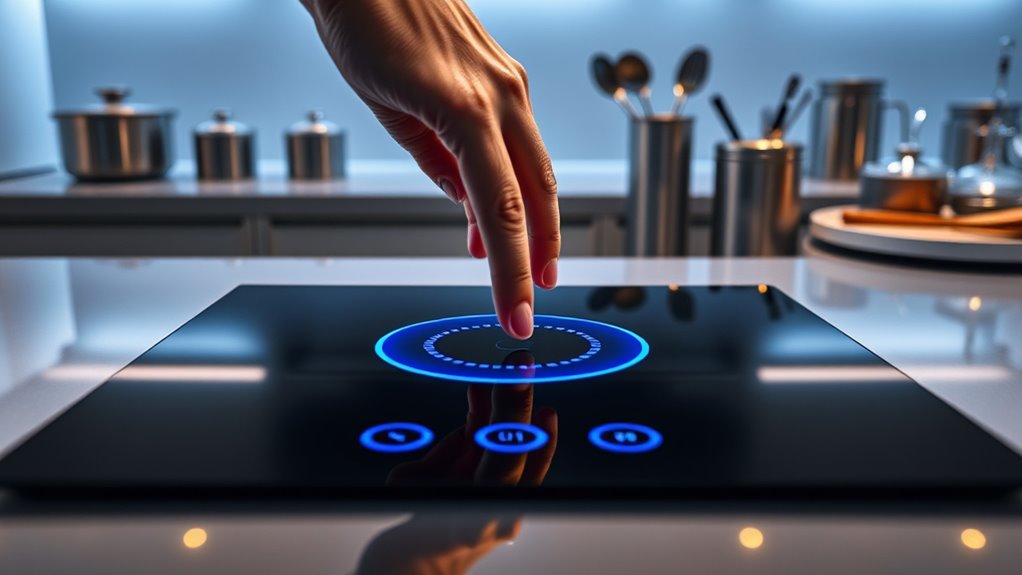
Advancements in induction technology are poised to transform cooking by making stoves more intelligent, versatile, and user-friendly. Future innovations include smart cookware that communicates directly with your stove, adjusting heat levels automatically for ideal cooking. Wireless controls will allow you to operate your induction stove remotely via smartphones or voice commands, increasing convenience and precision. Integration of sensors will enable real-time temperature monitoring, preventing overcooking or burning. Expect to see more customizable cooking programs tailored to specific recipes, making your kitchen more adaptable. These innovations will also promote energy efficiency by optimizing power use based on cookware and cooking needs. energy efficiency will become a fundamental aspect of future induction stoves, reducing waste and lowering utility bills. Overall, the future of induction technology promises a smarter, more connected, and efficient cooking experience that fits seamlessly into your modern lifestyle.
Frequently Asked Questions
How Long Do Induction Stoves Typically Last?
Induction stoves typically last about 10 to 15 years, depending on your usage and maintenance. Their stove durability is quite high, thanks to their sturdy build and fewer moving parts. You can expect a good lifespan, especially if you clean the surface regularly and avoid heavy impacts. Proper care guarantees you get the most out of your investment, making induction stoves a reliable choice for years to come.
Can Induction Stoves Be Used With Any Cookware?
You might wonder if induction stoves can use any cookware. Since they rely on magnetic properties, only cookware with magnetic bases works well. Check if your pots and pans are compatible by testing with a magnet—if it sticks, it’s suitable. Non-magnetic materials like glass or aluminum won’t work unless they have a magnetic layer. So, for the best performance, use cookware designed for induction cooking.
Do Induction Stoves Emit Any Harmful Radiation?
Imagine a gentle whisper of energy, not a roar of danger. Induction stoves emit electromagnetic safety signals, but they don’t produce harmful radiation exposure. You can cook confidently, knowing these stoves are designed with safety in mind. Unlike traditional methods, induction uses magnetic fields that stay confined, ensuring your kitchen remains a safe space. Rest assured, your health stays protected while you enjoy efficient, modern cooking.
Are Induction Stoves Suitable for Outdoor Cooking?
You can use induction stoves outdoors, but consider outdoor venting and weather resistance. Induction cooktops are generally safe outside, but make sure they’re protected from rain, snow, and extreme weather. Look for models designed with weather-resistant features, and set them up in a sheltered spot for better durability and safety. Proper outdoor venting isn’t usually necessary, but protecting the unit from the elements is essential for peak performance.
What Maintenance Is Required for Induction Cooktops?
Sure, maintenance for induction cooktops is a breeze—just like sparkling countertops. You’ll want to follow cleaning tips, like wiping with a soft cloth after use and avoiding abrasive cleaners. Safety precautions include keeping the surface clear of debris and checking that cookware is compatible. Regularly inspect for cracks or damage, and you’re good to go. It’s so simple, you might forget it’s even there—until it’s time to cook!
Conclusion
So, next time you’re still clanking around with outdated burners, remember that induction stoves are the smart, safe, and oh-so-efficient future. Why settle for slow heating, wasted energy, and potential burns when you can cook like a tech-savvy pro? Embrace the magic of induction — because your kitchen deserves the 21st century, not a fire hazard from the Stone Age. Upgrade now, and let your old stove envy your shiny new one.





